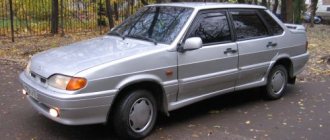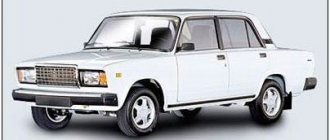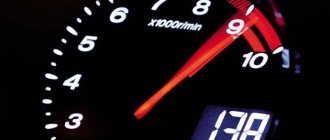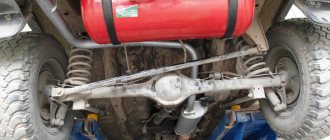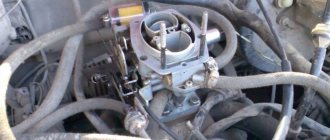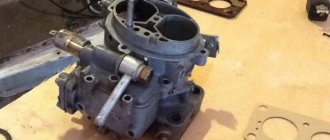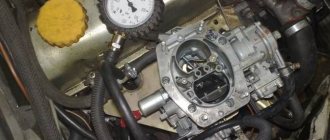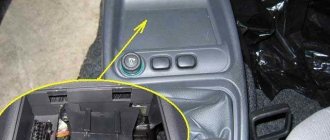Absolutely all Lada Kalina owners are interested in such an indicator as the fuel consumption of their car, and surely each of us wants to make it less. But there are many owners who even dream of factory performance.
The video above shows that the instantaneous consumption of my 8-valve Kalina at a speed of 100 km/h is no more than 5.8 liters, provided that the car has winter tires and the car is almost fully loaded. There is no catch there, AI-92 gasoline, I’m driving on a flat but very good road, I think that with summer tires the numbers would be even lower.
So, over my entire driving experience of 8 years and the total mileage on all my cars is at least 300,000 km, I have several comments and opinions about what can affect fuel consumption and how to moderate the engine’s appetite. This is my personal opinion and I do not impose it on anyone and do not insist that this is 100% true, but judging by my experience, everything was exactly like that.
[custom_ads_shortcode3]
Factors affecting fuel consumption:
[custom_ads_shortcode1]
Gasoline quality
This is probably the first point that you can think about in case of increased fuel consumption, because sometimes when refueling at different gas stations, the numbers on the on-board computer can differ significantly, even up to 2 liters per 100 km. This happened to me often, especially when I had to fill up with gasoline from unknown pumps.
I would give advice, if possible, fill up with fuel at trusted gas stations where you are satisfied with the quality. As for the octane number, I almost never notice the difference, especially at local filling stations and even Rosneft, but at Lukoil the 95 differs from the 92 for the better, I have been convinced of this more than once.
[custom_ads_shortcode2]
Low or uneven tire pressure
I think it’s no secret to anyone that not only the maneuverability and behavior of the car on the highway, but also the fuel consumption of your Lada Kalina depends on the pressure in the wheels. Before filming this video, which is located above, I drove 140 km to the village: so then, at the same speed, the consumption was about 6.5 liters on the same section of the road, but the right front wheel was lowered to 1 atmosphere, here is a real example of this , why did my Kalina eat more then?
[custom_ads_shortcode3]
Weather and road conditions
Naturally, in winter on a snowy road, the needle on the gasoline gauge will tend to zero faster than in dry weather and on summer tires. Heavy snow or rain, wind - all this negatively affects fuel consumption, as they create enormous resistance to the car body. In winter, of course, you have to spend even more money on gasoline, since you have to constantly warm up the engine.
[custom_ads_shortcode1]
Engine condition
Anyone who had a new Kalina or another car remembers that during the run-in they had to refuel more often, and after several thousand kilometers everything became normal. And also, if the piston is already worn out enough, the loss of compression will lead to a significant increase in fuel consumption.
[custom_ads_shortcode2]
DMVR sensor malfunction
This problem was on my previous VAZ 2112 car, where this mass air flow sensor constantly sent an error to the on-board computer and the instantaneous flow increased immediately from 0.6 to 1.3 liters per hour when the engine was idling. I had to constantly reset the error. So keep an eye on and replace the air filter more often than written in the operating instructions, thereby you will extend the life of the mass air flow sensor for many years.
There are still a bunch of different little things that can affect the fuel consumption of the Lada Kalina, from spark plugs to engine oil and the timing of its replacement, but I think it’s better to discuss this below in the comments. I hope that everyone has enough observations and thoughts on this matter.
[custom_ads_shortcode3]
Main components of the system
The air conditioning system in Lada Kalina includes various components, one of which is a condenser. This device is located in front of the engine cooling radiator in the corresponding compartment. It is fixed with brackets. Its honeycombs are made of aluminum tubes, which contain longitudinal partitions and ribs that improve heat transfer.
The tanks are made of aluminum and equipped with flanges that are connected to the pipelines. Each tank has sections. When the air conditioner is turned on, the fan starts, which improves heat exchange and reduces pressure in the system. If the part does not work, the capacitor is repaired.
The cabin filter should be changed periodically
It is recommended in the spring to wash the fins A and B of the unit from dirt that has accumulated on its surface. Such prevention improves heat transfer, reducing pressure and increasing the service life of the entire condensing system.
Do not wash the condenser with special installations that release a stream of water under high pressure, otherwise the thin-walled plates may be damaged. Using this flushing method results in frequent replacement of the capacitor. This is due to the fact that he is the first to fall under the flow of reagents and pebbles.
If the condenser seal is compromised due to corrosion, repairs will be expensive. The pressure in the system in summer can reach 25-28 bar. This takes into account the complex structure of the tube. The channels inside the capacitor may be blocked due to welding work. Such repairs lead to a decrease in power dissipation and deterioration in the operation of the air conditioner. Auto mechanics in this situation recommend installing a new capacitor.
Factory standard fuel consumption indicators for Lada Kalina
There are four main models of the Lada Kalina passenger car:
- sedan - has a closed body, with 2-3 rows of seats for the driver and passengers, the trunk is separated from the car interior, there is no lifting door in the rear wall;
- station wagon - has a closed cargo-passenger body, one of the sedan variants, which has an enlarged luggage compartment, is equipped with a lifting door in the rear wall;
- hatchback - has a body with 1-2 rows of driver and passenger seats, with a shortened rear overhang (hence the name - “hatchback” means “short”) and a smaller luggage compartment, equipped with a lift-up door in the rear wall;
- sport - is a sports version, which is equipped with a number of special parts - a bumper, an exhaust pipe tip, sports pedals, alloy wheels, a SAAZ Sport sports suspension, front and rear disc brakes, an original reinforced gearbox.
conclusions
If the on-board computer shows significantly more than 8.5 liters (and this is the average consumption in mixed mode), then this is a reason to think about the proper operation of the engine and its systems
If an increase in fuel consumption is detected on the Lada Kalina, the malfunction should be immediately diagnosed and repaired. There were cases when consumption reached 20 liters and only after that did motorists begin to do something. If the owner of a Lada Kalina cannot detect the fault himself, then it is worth contacting a car service center. The consequence of increased consumption may be increased wear of the elements of the power unit, which can lead to unplanned overhauls.
Real fuel consumption of Lada Kalina (according to reviews from car owners)
Many car owners of the Lada Kalina passenger car complain that in reality, gasoline consumption indicators differ from those specified by the manufacturer. For comparison, let’s look at another information table prepared by specialists taking into account feedback from Lada Kalina car owners.
Lada Kalina, 1.4 l When comparing two information tables, it is clear that the real indicators are indeed higher than the stated factory fuel consumption standards for the Lada Kalina. What are the reasons for this discrepancy between the figures?
The main reasons for the difference between the real and factory gas consumption figures for the Lada Kalina passenger car. There are several reasons for the discrepancy between the Lada Kalina's real gasoline consumption figures and the factory standards. Experienced car enthusiasts identify typical ones among them:
- Type of terrain - driving in the city, on the highway, off-road or mixed type of road (the more complex the type of road, the higher the fuel consumption).
- The driver's driving style is slow driving, fast driving, with sharp acceleration, with sharp braking (the more complex the driving style, the higher the gas consumption).
- The quality of the fuel used - AI-95 gasoline is consumed less than AI-92 gasoline.
- Time of year - in winter, fuel consumption rates will be higher, this is affected by icing of the road surface and frequent warming up of the vehicle itself.
- Traffic jams - due to slow driving and frequent braking, gasoline consumption increases by almost several liters.
- Using additional car devices (for example, air conditioning) – with devices constantly on, gasoline consumption will be 0.5-1 liter more.
In addition to the reasons listed, fuel consumption can be affected by various breakdowns of the vehicle itself:
- incorrect readings of the electronic engine control system due to sensor errors - temperature, mass air flow, oxygen, throttle position;
- abnormal pressure in the fuel system;
- internal combustion engine injector malfunction;
- failure of the catalyst;
- dirty air filter.
To install them, the car owner needs to diagnose the Lada Kalina passenger car. After diagnosing and identifying the causes of malfunctions, the vehicle is repaired.
[custom_ads_shortcode3]
Operation of climate control
Climate control system
To determine the causes of the malfunction of the unit in question, you first need to find out the principle of its operation and the refrigerant flow pattern. This system in Kalina includes the following elements:
- sensor;
- pipeline;
- radiator;
- fan;
- evaporator.
The air conditioning compressor is located on the BC of the engine. It works by rotating the belt. The compressor shaft is located on the housing. The air conditioner pulley is located on a bearing, which rotates regularly when the engine is running. The important elements of this mechanism are:
- friction clutch;
- electromagnetic drive.
Valve and evaporator design features
The evaporator is located in the air conditioner unit and is presented in the form of aluminum tubes with fins. The latter elements improve heat transfer. When the cabin fan turns on, air masses blow through the evaporator tubes. The air, cooling, flows into the cabin. At the bottom of the evaporator there is a tray and a drainage hole, which is designed to remove excess moisture from the interior of the Lada Kalina. Therefore, this hole must be free.
Another equally important element of the air conditioning system is the thermostatic valve, which is located in the evaporator housing. The refrigerant, passing through the hole, reduces the pressure and begins to boil. The valve body has a control element that changes the flow area of the hole taking into account:
If during the repair or replacement of parts of the air conditioning system at least 1 unit was opened, the receiver must be replaced with a new one. Otherwise, when charging the system, the refrigerant will not be drained. Acids can form inside the air conditioner, destroying parts of the main device.
Why does a warm engine stall?
Some motorists are faced with a situation where an already running and warmed-up engine suddenly stalls. Moreover, this happens after the sensor has recorded a set of normal operating temperatures. There may be several reasons for this. Next, we will consider them in more detail, and also indicate what needs to be done in this or that case.
- Poor quality fuel . This situation is typical, for example, if you are driving away from a gas station, and after a short period of time the engine begins to “cough”, the car jerks and stalls. The solution here is obvious - drain the low-quality fuel, bleed the fuel system and replace the fuel filter. It is also advisable to replace the spark plugs, but if they are new, you can get by by blowing them out. Naturally, you shouldn’t go to such a gas station in the future, but if you have saved your receipt, you can go there and make a claim about the quality of the fuel.
- Fuel filter . If the engine stalls, you should also check the condition of the fuel filter. And if according to the regulations it is already necessary to replace it, then this must be done, regardless of whether it is clogged or not yet.
- Air filter . The situation is similar here. The engine may “choke” on the rich mixture and stall shortly after starting. Check its condition and replace if necessary. By the way, this way you can also reduce fuel consumption.
- Gasoline pump . If it does not operate at full capacity, the engine will not receive enough fuel and, accordingly, will stall after a while.
- Generator . If it completely or partially fails, it stops charging the battery. The driver may not immediately notice this fact, start the engine and drive off. However, it will only drive until the battery is completely discharged. Unfortunately, it will no longer be possible to start the engine on it again. In some cases, you can try to tighten the alternator belt. If this procedure does not help, you need to call a tow truck or call your friends to have your car dragged to a garage or service station.
Popular on the site
Currently on the forum:
This page is searched for the following queries: Turn signals and emergency lights do not work as expected (Kalina), Lada Kalina forum, Lada Kalina discussion.
What if the fan completely stopped working?
To determine the cause of such a malfunction, you first need to check the condition of the fuse in the electrical circuit. It can be found on the side console, near the passenger seat. It is hidden under the deflector cover. By unscrewing the screw, the cover can be easily removed and the fuse will be available for examination.
To remove the entire safety block and connected relays, the mount must be released. You can't do this without wrenches. You need to remove the unit carefully without haste, as you can damage the wires that are connected to it. Only the single fuse of the unit is responsible for the operation of the fan.
If the fuse is intact, it is necessary to check the operation of the relay that powers the fan motor. There are two such relays installed. The left one turns on low fan speed. And the one located on the right is responsible for the high speed of its operation.
Another problem that relates to the cooling fan relay is that the cooling fan continues to operate when the ignition is turned off. This may drain the battery. “Kalina” then simply won’t start. The main reason is sticking contacts. The block is exposed to antifreeze leaking from the radiator installed above the stove.
When the relays and fuses are working properly, you need to check the operation of the temperature sensor. It is he who orders the fan to start working. This sensor is located on the right side of the radiator tank.
To check its functionality, you need to remove the plug connector, take a jumper, and use it to short-circuit the connector terminals. The fan turning on indicates that the sensor is in good condition. If the fan does not react at all, then before changing the sensor, you need to check the functionality of the fan motor. To do this, the electric motor terminals must be connected to the battery contacts. The engine should start working. In case of failure, you will have to install a new electric motor.
The operating principle of the air conditioner on Kalina and the refrigerant flow diagram
The cooling system of the Lada Kalina 8 cl and other models is similar in design. The compressor that ensures the operation of the system is located on the BC of an engine with 8 cells, etc., and operates when the belt rotates. The temperature in the cabin is regulated using a special knob on the climate control panel.
Scheme of operation of a car air conditioner
The car air conditioner, both for 8 cl engines and for others, is a sealed system that is filled with refrigerant. The unit operates by rotating the belt. The freon in the compressor heats up greatly due to the high pressure and flows through the pipeline into the air conditioner heater, where it cools. The gas is cooled thanks to the fan, which begins to work together with the compressor.
Having cooled, the freon condenses and turns into a liquid state, and then enters the receiver-dryer. The refrigerant then passes through the expansion valve and enters the evaporator. Here it turns into gas and cools greatly. At the same time, it cools the evaporator. Thanks to the fan, cooled air is blown from the evaporator and enters the cabin. The cold refrigerant returns to the compressor. So the process is repeated in a circle (the author of the video is L0RlC).
Where does antifreeze leak from and how to find the leak
Leaks in the radiator, pipes or other components can often be noticed by wet spots, accumulated drops of coolant, etc. If a visual inspection does not allow you to accurately detect the location of the leak, then during the search you should check all the components of the cooling system one by one.
- First of all, the expansion tank may be the culprit. It is also possible that antifreeze is leaking from under the cap. In this case, the coolant will evaporate through the cracks and cracks that appear on the tank body or lid. It can be difficult to visually identify such a malfunction, since leaks through microcracks are almost invisible. To eliminate the malfunction, it is better to change the tank and/or cap.
- Another reason for increased antifreeze consumption may be pipes and connections. In this case, it is easier to detect the leak. Many car enthusiasts use a simple method, which is to place a sheet of paper under the car. If the car has engine protection, then the sheet is placed on the protection. Then the car is parked. The appearance of coolant stains is a reason to inspect the pipes, hoses, as well as their connections to the radiator of the cooling system. The thermostat gasket also deserves special attention, since antifreeze leaks from under the thermostat are quite common. The thermostat housing may also be faulty. In such a situation, the device is changed.
How to fill it yourself?
Before you start refueling, you need to get rid of moisture and air using a vacuum pump.
For Lada Kalina, it is recommended to purchase R-134a freon. For refueling, use a special refueling kit, which has two hoses and a ball valve.
Filling the climate system with freon consists of the following sequence of actions:
- The car needs to be put on the handbrake and put in neutral.
- Before connecting the filling kit hose to the low pressure port, it must be cleaned of dirt.
- When the hose is connected, you need to start the engine.
- The second hose should be connected to the freon cylinder.
- During refilling, you need to press the gas pedal so that the refrigerant is evenly distributed throughout the air conditioning system. Cooled air should enter the cabin.
- When refueling is complete, remove the hose from the low pressure port and screw on the cap.
This completes freon charging. Now you need to turn on the car air conditioner and check how it works.
